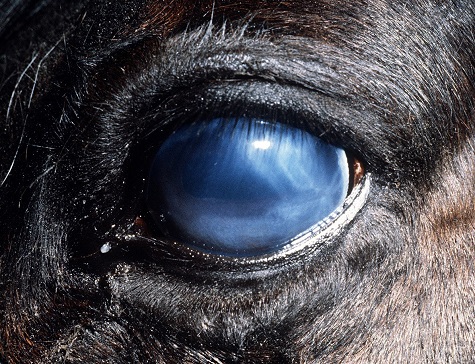Moon blindness, also known as equine recurrent uveitis (ERU), is a common and challenging eye condition that affects horses. It is characterized by recurring episodes of inflammation in the uveal tract of the eye, leading to discomfort, vision impairment, and potentially even blindness. Recognizing the signs of moon blindness in its early stages is crucial for prompt treatment and minimizing long-term damage.
Identifying Moon Blindness
Ocular Discharge

One of the primary signs of moon blindness is the presence of ocular discharge. This discharge may vary in color and consistency, ranging from watery and clear to thick and yellowish.
Redness and Swelling
Affected horses may exhibit redness and swelling around the eye. The conjunctiva, the thin, transparent tissue covering the sclera (white part) of the eye, may appear inflamed and irritated.
Squinting and Sensitivity to Light
Horses with moon blindness often display squinting or excessive blinking. They may also demonstrate increased sensitivity to light, commonly known as photophobia.
Cloudiness and Change in Eye Color
The affected eye may appear cloudy, with a bluish or grayish tint. Additionally, some horses may experience a change in the color of their iris, turning lighter or darker.
Recurring Episodes
Moon blindness typically manifests as recurrent episodes of eye inflammation. The severity and frequency of these episodes can vary from horse to horse.
Treatment Options
Veterinary Examination
At the first sign of moon blindness, consult a veterinarian experienced in equine ophthalmology. They will conduct a thorough examination to confirm the diagnosis and determine the best course of treatment.
Medications
Treatment for moon blindness often involves the administration of anti-inflammatory medications, such as corticosteroids or non-steroidal anti-inflammatory drugs (NSAIDs). These medications help reduce inflammation and alleviate pain. Prescription eye drops or ointments may also be recommended to provide local relief.
Management of Underlying Causes
Identifying and managing any underlying causes or triggers of moon blindness is crucial. Potential causes may include infections, parasites, or autoimmune disorders. Your veterinarian may prescribe specific treatments or recommend preventive measures.
Environmental Control
Creating a horse-friendly environment can help manage moon blindness. Provide shade or a fly mask with UV protection to minimize exposure to direct sunlight, as sunlight can trigger flare-ups. Minimize exposure to dust, pollen, and other allergens that may exacerbate the condition.
Regular Monitoring
Once diagnosed, horses with moon blindness require lifelong management and regular veterinary check-ups. Monitoring the horse’s condition and promptly addressing any recurrence of symptoms are vital for maintaining eye health.
Additional Resources
For further information on moon blindness in horses and its treatment, consider referring to the American Association of Equine Practitioners. The AAEP provides a comprehensive collection of articles and resources on equine health, including moon blindness and other eye conditions.
TheHorse.com offers information on horse health and care. Their articles cover various topics related to equine eye conditions and provide insights into managing moon blindness.
Conclusion
Early detection and appropriate treatment are crucial in managing moon blindness in horses. By recognizing the signs and promptly seeking veterinary care, horse owners can provide the necessary support to alleviate discomfort and preserve their horse’s vision. Remember to consult with a qualified veterinarian for accurate diagnosis and tailored treatment plans to address this challenging eye condition effectively.
Related Articles & Free Email Newsletter Sign Up
Are You Deworming your Horse Every Few Weeks? It May Not be Necessary
Natural Hoof Care for Horses: A Holistic Approach to Equine Well-Being
The American Paint Horse is a Masterpiece of Color and Versatility


Comment here